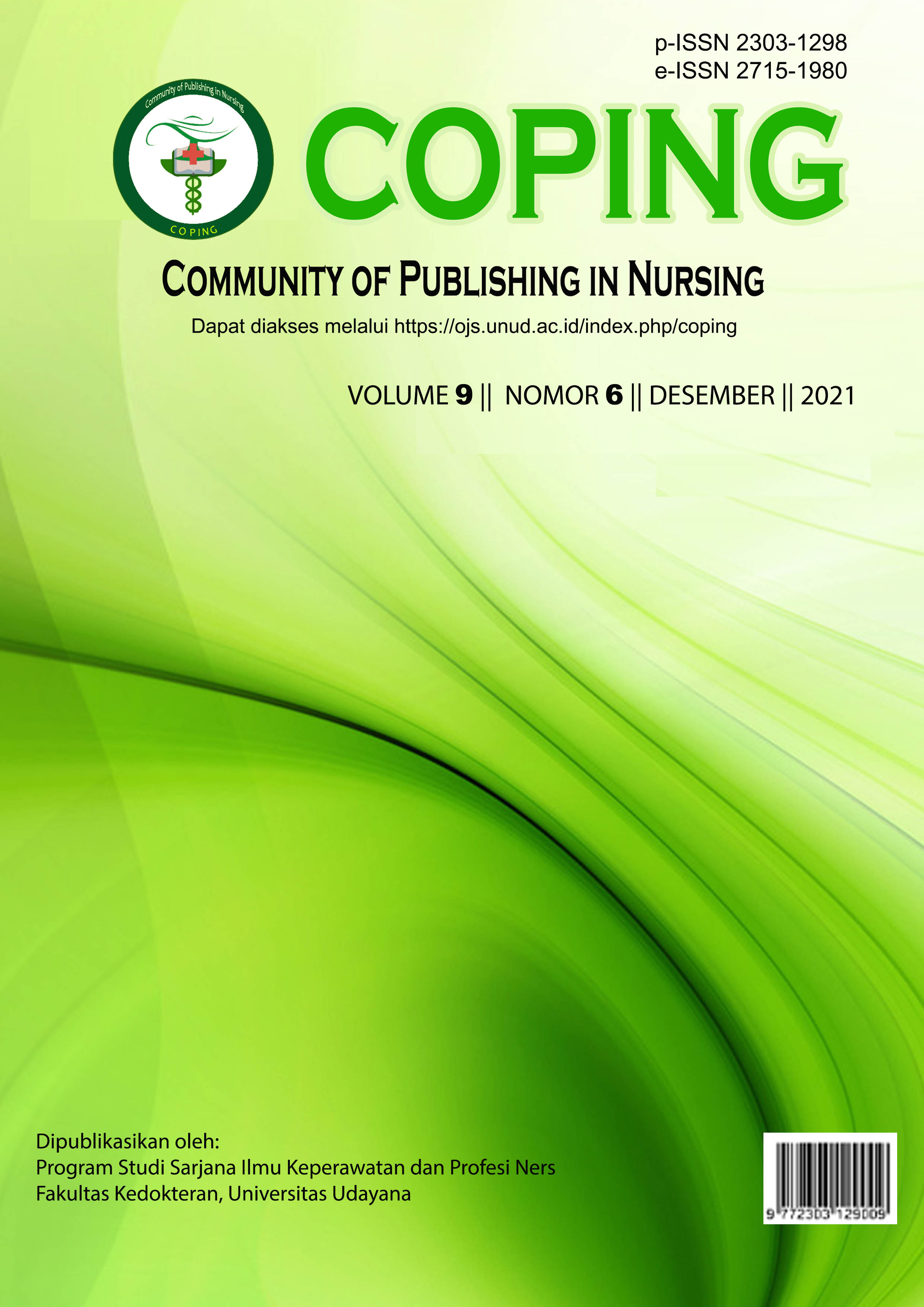KAJIAN LITERATUR SISTEMIK : TEKNOLOGI DIGITAL DALAM MENILAI HALUSINASI
Abstract
Dalam melayani pasien, terutama pasien gangguan psikotik, perawat dihadapkan pada keadaan dimana pasien mengalami halusinasi. Perilaku halusinasi yang berat kadang dengan mudah dinilai, namun gejala halusinasi yang samar-samar dan yang bersifat ringan, terkadang luput dari observasi. Teknologi digital yang dikembangkan baik secara audio maupun visual serta Virtual Reality dapat dengan cepat menilai munculnya gejala halusinasi, memantau perilaku halusinasi, sehingga mencegah halusinasi menjadi berat dan mencegah kekambuhan. Akhirnya, pasien dapat melewati halusinasi yang muncul, dan keluarga mudah mencari layanan kesehatan secepatnya jika secara dini mengetahui perilaku pasien yang mengalami halusinasi. Tinjauan literatur ini bertujuan menggambarkan perkembangan teknologi digital dalam penilaian halusinasi. Penelitian ini menggunakan metode tinjauan literatur. Database yang digunakan yaitu ScienceDirect, Scopus, Spingerlink dan Oxford Journals. Artikel dengan beberapa kata kunci, seperti penilaian halusinasi, halusinasi, teknologi digital penilaian halusinasi. Penggunaan teknologi digital dalam menilai halusinasi dapat memperbaiki kualitas asuhan. Dibutuhkan pengembangan lanjutan dalam teknologi digital untuk menilai gejala halusinasi.
Katakunci: halusinasi, “penilaian halusinasi”, “teknologi digital penilaian halusinasi”
Downloads
References
Craig, T. K., Rus-Calafell, M., Ward, T., Leff, J. P., Huckvale, M., Howarth, E., Emsley, R., & Garety, P. A. (2018). AVATAR therapy for auditory verbal hallucinations in people with psychosis: a single-blind, randomised controlled trial. The Lancet Psychiatry, 5(1), 31–40. https://doi.org/10.1016/S2215-0366(17)30427-3
Dellazizzo, L., Potvin, S., Phraxayavong, K., & Dumais, A. (2021). One-year randomized trial comparing virtual reality-assisted therapy to cognitive–behavioral therapy for patients with treatment-resistant schizophrenia. Npj Schizophrenia, 7(1). https://doi.org/10.1038/s41537-021-00139-2
Dupuy, M., Abdallah, M., Swendsen, J., N’Kaoua, B., Chanraud, S., Schweitzer, P., Fatseas, M., Serre, F., Barse, E., Auriacombe, M., & Misdrahi, D. (2021). Real-time cognitive performance and positive symptom expression in schizophrenia. European Archives of Psychiatry and Clinical Neuroscience, 0123456789. https://doi.org/10.1007/s00406-021-01296-2
Fovet, T., Yger, P., Lopes, R., de Pierrefeu, A., Duchesnay, E., Houenou, J., Thomas, P., Szaffarczyk, S., Domenech, P., & Jardri, R. (2021). Decoding Activity in Broca’S Area Predicts the Occurrence of Auditory Hallucinations Across Subjects. Biological Psychiatry. https://doi.org/10.1016/j.biopsych.2021.08.024
García, A. S., Fernández-Sotos, P., Vicente-Querol, M. A., Sánchez-Reolid, R., Rodriguez-Jimenez, R., & Fernández-Caballero, A. (2021). Co-design of avatars to embody auditory hallucinations of patients with schizophrenia: A study on patients’ feeling of satisfaction and psychiatrists’ intention to adopt the technology. Virtual Reality, 0123456789. https://doi.org/10.1007/s10055-021-00558-7
Garety, P., Edwards, C. J., Ward, T., Emsley, R., Huckvale, M., McCrone, P., Rus-Calafell, M., Fornells-Ambrojo, M., Gumley, A., Haddock, G., Bucci, S., McLeod, H., Hardy, A., Peters, E., Myin-Germeys, I., & Craig, T. (2021). Optimising AVATAR therapy for people who hear distressing voices: study protocol for the AVATAR2 multi-centre randomised controlled trial. Trials, 22(1), 1–17. https://doi.org/10.1186/s13063-021-05301-w
Graña, M., Ozaeta, L., & Chyzhyk, D. (2019). Dynamic Causal Modeling and machine learning for effective connectivity in Auditory Hallucination. Neurocomputing, 326–327, 61–68. https://doi.org/10.1016/j.neucom.2016.08.157
Jardri, R., Larøi, F., Waters, F., Woodward, T., Aleman, A., Allen, P., Fernyhough, C., McCarthy-Jones, S., & Sommer, I. (2019). Hallucination Research: Into the Future, and beyond. Schizophrenia Bulletin, 45(1), S1–S4. https://doi.org/10.1093/schbul/sby170
Jongeneel, A., van Veen, S. C., Scheffers, D., Riper, H., van den Hout, M. A., van der Gaag, M., & van den Berg, D. (2020). Linguistic dual tasking reduces emotionality, vividness and credibility of voice memories in voice-hearing individuals: Results from a controlled trial. Schizophrenia Research, 216, 249–254. https://doi.org/10.1016/j.schres.2019.11.048
Kruk, D., Mętel, D., Gawęda, Ł., & Cechnicki, A. (2021). Implementation of virtual reality (VR) in diagnostics and therapy of nonaffective psychoses. Psychiatria Polska, 54(5), 951–975. https://doi.org/10.12740/PP/ONLINEFIRST/113437
Moore, E., Williams, A., Bell, I., & Thomas, N. (2020). Client experiences of blending a coping-focused therapy for auditory verbal hallucinations with smartphone-based ecological momentary assessment and intervention. Internet Interventions, 19(December 2019), 100299. https://doi.org/10.1016/j.invent.2019.100299
Riva, G., & Serino, S. (2020). Virtual reality in the assessment, understanding and treatment of mental health disorders. Journal of Clinical Medicine, 9(11), 1–9. https://doi.org/10.3390/jcm9113434
Selvaraj, S., Chhabra, H., Dinakaran, D., Sreeraj, V. S., Venkataram, S., Narayanaswamy, J. C., Kesavan, M., Varambally, S., & Venkatasubramanian, G. (2021). Auditory signal detection in schizophrenia: Correlates with auditory verbal hallucinations & effect of single session transcranial direct current stimulation (tDCS). Psychiatry Research, 297(July 2020), 113704. https://doi.org/10.1016/j.psychres.2021.113704
Thunnissen, M. R., aan het Rot, M., van den Hoofdakker, B. J., & Nauta, M. H. (2021). Youth Psychopathology in Daily Life: Systematically Reviewed Characteristics and Potentials of Ecological Momentary Assessment Applications. Child Psychiatry and Human Development, 0123456789. https://doi.org/10.1007/s10578-021-01177-8







